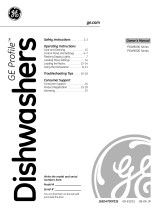Consumer SupportTroubleshooting TipsOperating InstructionsSafety Instructions
Prior to the first use, the dishwasher needs to
be calibrated for water hardness. Please follow
directions below to calibrate the dishwasher to
the hardness of your tap water.
Determine the Hardness of Your Tap Water
In the bag that contained these instructions, you
should find a water hardness test strip package. Read
the instructions on the package, remove the test strip
and follow the instructions to determine the hardness
level of your tap water. You will use this information to
calibrate your dishwasher to dispense the optimal
amount of detergent.
Water hardness test strip indication
Calibration of 12-Button Front-Control
Models With 3-Digit Display
Close and latch the door (lights on, dishwasher
not running).
Press the COOKWARE or DEEP CLEAN
and DELAY HOURS pads at the same time
for 3 seconds. The display will show a number
from 1 to 5. This is the water hardness value
currently set.
Press the COOKWARE or DEEP CLEAN pad
to raise the value or the NORMAL pad to lower
the value. Set the water hardness value to the
number determined with the test strip and table
above.
Once the water hardness is set, press the
START/RESET pad to save the setting and return
the dishwasher to normal operation.
Calibration of 7-Button Top-Control Models
With 3-Digit Display
Open the door and touch a pad (other than
START) to turn lights on.
Press the “Up” Arrow Pad and DELAY
HOURS pad at the same time for 3 seconds.
The display will show a number from 1 to 5.
This is the water hardness value currently set.
Press the “Up” Arrow Pad to raise the value
or the “Down” Arrow Pad to lower the value.
Set the water hardness value to the number
determined with the test strip and table at the left.
Once the water hardness is set, press the
START/RESET pad to save the setting and return
the dishwasher to normal operation.
Calibration of Models Without a 3-Digit Display
Front controls
Close and latch the door (lights on, dishwasher
not running).
Press the COOKWARE or DEEP CLEAN and
DELAY HOURS pads together for 3 seconds.
All lights will light up and you will hear 1 to 5
beeps. The number of beeps indicates the current
hardness value.
To change the setting, press the DELAY HOURS
pad the number of times that corresponds to the
water hardness value determined at the left. The
control will beep each time you press the pad.
Once finished pressing the pad, you will hear a
confirmation with beeps for the number of times
you pressed the pad.
If the number of beeps is not what you desire,
start pressing the DELAY HOURS pad again to
reenter a new water hardness level.
Once the water hardness is set, press the
START/RESET pad to save the setting and return
the dishwasher to normal operation.
Top controls
Open the door and touch a pad to turn lights on.
Press the “Up” Arrow Pad and DELAY
HOURS pad at the same time for 3 seconds. All
lights will light up and you will hear 1 to 5 beeps.
The number of beeps indicates the current
hardness value.
To change the setting, press the DELAY HOURS
pad the number of times that corresponds to the
water hardness value determined at the left. The
control will beep each time you press the pad.
Once finished pressing the pad, you will hear a
confirmation with beeps for the number of times
you pressed the pad.
If the number of beeps is not what you desire,
start pressing the DELAY HOURS pad again to
reenter a new water hardness level.
Once the water hardness is set, press the
START/RESET pad to save the setting and return
the dishwasher to normal operation.
NOTE: You should recalibrate the dishwasher control
if water conditions change; for example, if a water
softener system is added or removed from your
home.
6
5
4
3
2
1
6
5
4
3
2
1
4
3
2
1
4
3
2
1
ge.com
SmartDispense
TM
Detergent Dispenser
Water Hardness Calibration
0 RED
1 RED
2 RED
3 RED
4 RED
1
2
3
4
5
SOFT
HARD
Value to Enter
into Dishwasher
Press at the same time.
Display
Press at the same time.
Display
11























